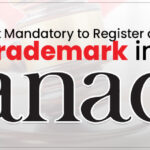Canada Trademark Registration is a vital step for businesses looking to protect their brand identity and intellectual property in the Canadian market. Understanding the nuances of trademark registration in Canada is essential for ensuring a smooth and successful process. In this comprehensive guide, we’ll delve into the intricacies of Canada Trademark Registration, covering everything from the types of trademarks recognized in Canada to the registration process, fees, and renewal requirements.
Types of Trademarks in Canada:
Canada recognizes various types of trademarks, each offering distinct forms of protection:
1. Ordinary Mark: This encompasses a wide range of elements, including words, designs, packaging, moving images, tastes, textures, shapes, holograms, colours, sounds, scents, or combinations thereof. Essentially, anything that can uniquely identify the source of a product or service can be registered as an ordinary mark in Canada. For example, a company name, logo, or a unique sound associated with a product can all be registered as ordinary marks.
Canada Trademark Registration Example: A company named “Maple Leaf Bakery” can register its name as an ordinary mark to protect its brand identity in the bakery industry.
2. Certification Mark: These are used to indicate that goods or services comply with specific standards or possess certain characteristics, typically related to quality, origin, material, or mode of manufacture. Unlike ordinary marks, certification marks are not used by the owner but by others who meet the defined standards. They ensure consumers that products or services bearing the mark meet certain quality or authenticity standards.
Read also this -: How to Check if a Trademark is Oppositional in Canada
Canada Trademark Registration Example: The “Organic Canada” certification mark is used by products that have been certified as organic by a recognized certification body, indicating compliance with organic farming standards.
3. Distinguishing Guise: This type of trademark protects the unique appearance or packaging of a product, rather than its name or logo. It is particularly relevant for products where the packaging or shape plays a significant role in distinguishing the product in the marketplace. Distinguishing guise protection prevents others from copying the unique visual aspects of a product’s packaging or design.
Canada Trademark Registration Example: The distinctive shape of the Coca-Cola bottle can be registered as a distinguishing guise, protecting it from imitation by competitors.
In summary, Canada offers protection for various types of trademarks, including ordinary marks, certification marks, and distinguishing guises, each serving to safeguard different aspects of a brand’s identity or product’s uniqueness in the marketplace.
Understanding the limitations and features of trademark registration in Canada is crucial for applicants. Certain restrictions apply, such as the inability to register trademarks that are similar to existing ones, descriptive signs, misleading signs, or trademarks indicating geographical origin unless the goods originate from that area.
Trademark Search and Application Process:
Before filing a trademark application, conducting a thorough search in the Canadian Trademarks Database is advisable to ensure the uniqueness of the proposed mark. The application process involves providing details such as the applicant’s name and address, trademark representation, goods/services associated with the mark, and the application fee.
The application must comply with specific requirements, including grouping goods/services according to the Nice Classification and paying the applicable fees. Each trademark requires a separate application, although one application can cover multiple goods/services.
Trademark Registration Canada: Search and Application Process:
1. Conducting a Comprehensive Search:
- Utilize the Canadian Trademarks Database to conduct a thorough trademark search.
- Ensure the uniqueness and availability of the proposed mark.
- Determine any trademarks currently in use that might conflict with the proposed mark.
2. Preparing the Application:
- Gather necessary information, including the applicant’s name and address.
- Choose a suitable representation of the trademark, such as a logo or wordmark.
- Clearly define the goods/services associated with the mark.
- Ensure accuracy and completeness of the application form.
3. Compliance with Requirements:
- Group goods/services according to the Nice Classification system.
- Classify goods/services accurately to align with the trademark’s intended use.
- Pay attention to specific requirements outlined by the Canadian Intellectual Property Office (CIPO).
4. Submission of Application:
- File the trademark application electronically through the CIPO’s online portal.
- Provide all necessary details and documentation as per the application form.
- Ensure timely submission to avoid delays in processing.
5. Application Review Process:
- The CIPO conducts a thorough examination of the application.
- Assessments include the uniqueness of the mark, compliance with requirements, and potential conflicts with existing trademarks.
- Any deficiencies or issues may result in communication from the CIPO for clarification or amendment.
6. Publication and Opposition Period:
- After passing the examination, the trademark application is published in the Trademarks Journal.
- A 2-month opposition period allows third parties to oppose the registration of the mark if they believe it infringes upon their rights.
- If no opposition is filed within the designated period, the application proceeds to registration.
7. Registration and Issuance of Certificate:
- The trademark is registered after the opposition period is successfully concluded.
- The CIPO issues a Certificate of Trademark Registration, confirming the exclusive rights to use the trademark in association with the specified goods/services.
- Maintain the registration by fulfilling renewal requirements as per the Canadian trademark law.
8. Enforcement and Protection:
- Trademarks that are registered are legally protected from infringement and unlawful usage.
- Owners can take legal action against infringers to defend their trademark rights.
- Regular monitoring and enforcement efforts help safeguard the integrity and exclusivity of the registered mark.
By following these detailed steps and ensuring compliance with the requirements outlined in the Trademark Registration Canada process, applicants can successfully register their trademarks and secure exclusive rights to their valuable intellectual property assets.
Read also this -: Do You Need a Lawyer for Trademark Registration in Canada
Timeline and Costs:
The timeline for trademark registration in Canada typically takes around 24 months, provided there are no objections from third parties. However, engaging the services of a reputable patent agency like TrademarkCart can expedite the process by ensuring accurate document preparation.
Benefits of Choosing TrademarkCart as your partner:
TrademarkCart offers comprehensive support for trademark registration in Canada, including consulting, professional verification, document preparation, application filing, attorney representation, and maintenance services. Their expertise and efficient processes streamline the registration process, providing applicants with peace of mind and ensuring compliance with all legal requirements.
Trademark Renewal:
To maintain trademark registration in Canada, renewal fees must be paid every 10 years. Additionally, during the fifth and sixth years after registration, proof of continuous use (section 8 declaration) and a declaration of incontestability (section 15 declaration) can be filed to strengthen the trademark’s protection against third-party challenges.
Trademark Registration Renewal Process in Canada
1. Renewal Period:
- Trademark registrations in Canada must be renewed every 10 years to maintain validity.
- Failure to renew within the specified period can result in the loss of trademark rights.
2. Payment of Renewal Fees:
- Renewal fees must be paid to the Canadian Intellectual Property Office (CIPO) within the renewal period.
- The amount of renewal fees may vary and is subject to change over time.
3. Submission of Renewal Application:
- File a renewal application with the CIPO to initiate the renewal process.
- Provide accurate details, including the trademark registration number and owner information.
4. Verification of Trademark Registration:
- The CIPO verifies the validity of the trademark registration before processing the renewal application.
- Ensure that the trademark remains in compliance with all relevant regulations and requirements.
5. Confirmation of Renewal:
- Upon successful processing of the renewal application and payment of renewal fees, the CIPO confirms the renewal of the trademark registration.
- A renewed certificate of registration may be issued to the trademark owner as proof of renewal.
6. Maintenance of Continuous Use:
- In addition to renewal, trademark owners must demonstrate continuous use of the mark to maintain registration validity.
- Submit a section 8 declaration during the fifth year after registration, confirming ongoing use of the trademark in commerce.
Read also this -: How to Register your Business Trademark in Canada
7. Declaration of Incontestability:
- Optionally, during the sixth year after registration, trademark owners can file a section 15 declaration of incontestability.
- This declaration strengthens the trademark’s protection by establishing its incontestable status, making it more difficult for third parties to challenge its validity.
8. Compliance with Renewal Requirements:
- Ensure compliance with all renewal requirements and deadlines to avoid the expiration of trademark registration.
- Stay informed about any changes in renewal procedures or regulations issued by the CIPO.
9. Enforcement of Renewed Trademark Registration:
- A renewed trademark registration grants exclusive rights to the trademark owner to use the mark in association with the registered goods/services.
- Owners can enforce their trademark rights against unauthorized use or infringement through legal means.
10. Monitoring and Maintenance:
- Regularly monitor the marketplace for potential infringement or misuse of the trademark.
- Stay proactive in maintaining and protecting the integrity of the renewed trademark registration.
By following these detailed steps and fulfilling the necessary requirements for Trademark Registration renewal in Canada, trademark owners can ensure the continued protection and validity of their valuable intellectual property assets.
Conclusion:
Canada Trademark Registration is a vital step for businesses seeking to safeguard their brand identity and intellectual property rights. Understanding the trademark types, application process, timeline, costs, and renewal requirements is essential for a successful registration process. Partnering with a reputable patent agency like TrademarkCart can streamline the process and ensure compliance with all legal obligations, providing applicants with comprehensive support and peace of mind.


